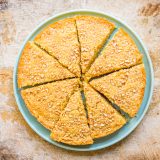There's nothing wrong with the multi-tiered, elaborately iced and lavishly coated coconut cake of the American South. But there is an easier way to make coconut cake.
We found it in Burma, where the moist, dense semolina cake sanwin makin gets rich flavor from coconut cream.
The cake riffs on halwa, an Indian dessert similar to rice pudding that's made from toasted semolina. To make traditional sanwin makin, Burmese cooks combine semolina, coconut cream and sugar in a saucepan, then cook it, whisking in eggs and clarified butter, until it has a thick porridge-like consistency. That batter goes into a pan and is baked until golden brown. Finally, the spongy single-layer cake is topped with sesame seeds for crunch.
In the U.S., semolina is better known for making pizza, breads and pasta, but the coarse yellow wheat flour has a nutty, faintly sweet flavor that makes it well-suited for desserts. In Morocco, it's used to make makrout (date-filled cookies); in Singapore, it's the base of almond-flavored sugee cake; and in Turkey and Greece, the spiced semolina cake revani is soaked with flavored syrup.
But semolina’s high protein content can make cakes dense, sometimes almost gluey. For our version of sanwin makin, we wanted to lighten its texture and streamline the process.
To do that, we skipped the stovetop entirely and instead toasted the semolina as well as some shredded coconut. After they were fragrant and golden, we immediately soaked them in coconut milk—rather than coconut cream—until all the liquid was absorbed. Then we whisked in brown sugar, butter, eggs, baking powder, cardamom and salt.
The result was a springier, airer coconut cake that otherwise hewed closely to traditional sanwin makin. But we did make one more deviation: Instead of sesame seeds, we used toasted coconut and cashews to add a nutty, crunchy topping.




